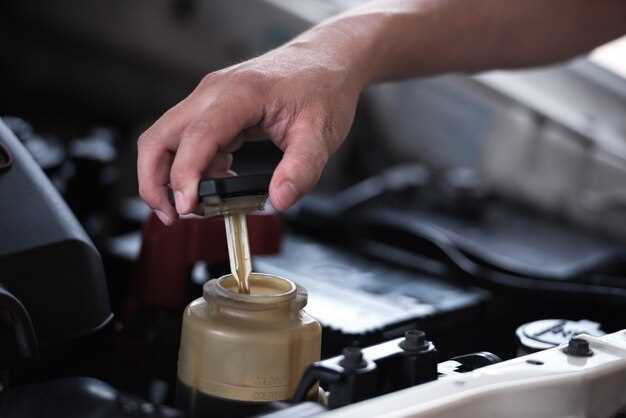
Proper maintenance of your vehicle’s transmission is crucial for ensuring its longevity and optimal performance. One of the key aspects of this maintenance is monitoring and replacing the transmission fluid. This fluid not only lubricates the various components within the transmission but also helps in cooling and providing hydraulic pressure necessary for smooth gear shifts.
Over time, transmission fluid can degrade due to heat, contaminants, and wear from repetitive use. As such, understanding how often to replace this vital liquid can prevent significant damage to your vehicle’s transmission. Failing to do so may lead to increased friction, overheating, and ultimately, costly repairs or premature transmission failure.
Generally, it is recommended to check the transmission fluid level and condition every 30,000 to 60,000 miles, depending on the vehicle’s make and model. However, some manufacturers may advise replacing it as frequently as every 15,000 miles. Always refer to your owner’s manual for specific guidelines. Regular checks and timely replacements will save money in the long run and enhance your vehicle’s performance.
Understanding Transmission Fluid Types
Transmission fluid is crucial for the proper functioning of your vehicle’s transmission system. There are several types of transmission fluid, each specifically designed for different types of transmissions and operating conditions. Understanding these fluid types can help you choose the right maintenance schedule for your vehicle.
The most common types of transmission fluid include Automatic Transmission Fluid (ATF), Manual Transmission Fluid, and Continuously Variable Transmission (CVT) fluid. ATF is used in most automatic transmissions and contains additives that provide improved lubrication and cooling properties. Manual transmission fluid is typically thicker and designed to withstand higher pressure and friction levels found in manual gear shifting. CVT fluid is specially formulated for vehicles with continuously variable transmissions, ensuring optimal performance and efficiency.
Additionally, there are synthetic transmission fluids available that provide enhanced protection and longevity compared to conventional fluids. These synthetic options can withstand higher temperatures and offer better overall performance, making them ideal for high-performance vehicles. Regular maintenance, including checking and replacing the transmission fluid as needed, is essential to prevent wear and tear on the transmission components.
Always refer to your vehicle’s owner manual for the correct type of transmission fluid and maintenance intervals. Using the appropriate fluid not only improves transmission function but also extends its lifespan, reducing the need for costly repairs in the future.
Signs Your Transmission Fluid Needs Replacement
Monitoring the condition of your transmission fluid is crucial for the longevity of your vehicle. Here are some key signs that indicate your transmission fluid may need replacement.
First, a burnt smell coming from the transmission fluid is a clear warning sign. Healthy fluid should have a slightly sweet odor. If you detect a burnt or acrid scent, it indicates overheating and potential degradation of the fluid.
Another significant indicator is a change in color. New transmission fluid is typically red or pink. As it ages, it may turn brown or dark, signaling contamination or oxidation that necessitates a fluid change.
Additionally, if you experience difficulty in shifting gears, such as slipping between gears or delayed engagement, it may point to insufficient or contaminated transmission fluid. Adequate fluid levels are essential for proper transmission operation.
Unusual noises from the transmission, such as grinding or whining sounds, can also be a red flag. These noises often suggest that the fluid is not lubricating the components effectively, leading to wear and tear.
Lastly, if you notice a fluid leak beneath your vehicle, it’s essential to check the transmission fluid levels. A significant drop in fluid levels can compromise the transmission’s performance and signal the need for replacement.
Regularly inspecting your transmission fluid for these signs can help maintain your vehicle’s performance and prevent costly repairs in the future.
Manufacturer Recommendations for Fluid Change Intervals
When it comes to transmission maintenance, following the manufacturer’s recommendations is crucial for ensuring the longevity and performance of your vehicle. Each automaker provides specific guidelines for fluid change intervals based on the design and engineering of their transmissions.
Typically, manufacturers advise changing the transmission fluid every 30,000 to 60,000 miles. However, some modern vehicles are equipped with advanced transmission systems that may extend this interval up to 100,000 miles or more. It’s essential to consult your vehicle’s owner manual for the exact recommendations pertinent to your model.
In addition to mileage, driving conditions also play a significant role in determining how often to replace transmission fluid. For example, frequent stop-and-go traffic, towing, or driving in harsh weather conditions can lead to faster fluid degradation. In such cases, manufacturers may recommend more frequent changes to safeguard the transmission against potential damage.
Moreover, some manufacturers advocate replacing the fluid every two years, regardless of mileage, to maintain optimum performance. Regularly checking fluid levels and quality can help identify when a change is necessary, even if it’s ahead of the scheduled interval.
Following these manufacturer guidelines not only helps in maintaining the efficiency of your transmission but also aids in preventing costly repairs down the line. Staying proactive about transmission maintenance is key to a smooth and reliable driving experience.
The Impact of Driving Conditions on Fluid Longevity

The longevity of transmission fluid is significantly influenced by various driving conditions. Understanding these factors can help vehicle owners determine when it’s time to replace their transmission fluid, ensuring optimal performance and longevity of the transmission system.
-
Traffic Conditions:
Frequent stop-and-go traffic can cause the transmission to work harder, leading to higher temperatures and accelerated fluid breakdown. In such scenarios, it is advisable to check and replace the fluid more regularly.
-
Climate:
Extreme temperatures, whether hot or cold, can impact transmission fluid quality. Hot climates can cause fluid to degrade faster due to increased heat, while cold climates may lead to thickening of the fluid, affecting its performance.
-
Driving Style:
Aggressive driving, including rapid acceleration and hard braking, puts extra strain on the transmission. This increased demand can lead to a quicker deterioration of the fluid, necessitating more frequent changes.
-
Towing and Hauling:
If you frequently tow heavy loads or haul heavy items, your transmission is under greater stress. This added strain can cause the fluid to break down faster, requiring more regular maintenance.
-
Road Conditions:
Potholes, rough terrains, and unpaved roads can also contribute to higher fluid temperatures and increased wear on the transmission, which may necessitate more frequent fluid replacements.
Regularly assessing driving conditions and adapting maintenance schedules accordingly can help ensure that your transmission fluid remains effective, maintaining the overall health of your vehicle’s transmission system.
How to Check Your Transmission Fluid Level

Checking your transmission fluid level is a crucial aspect of vehicle maintenance. Proper fluid levels ensure that the transmission operates smoothly and efficiently. Here’s a step-by-step guide on how to perform this essential task.
1. Gather Necessary Tools: To check the transmission fluid, you’ll need a clean dipstick or funnel, a rag for wiping, and possibly a container to catch any overflow fluid.
2. Locate the Transmission Dipstick: Most vehicles equipped with an automatic transmission have a dipstick located near the back of the engine. Refer to your owner’s manual if you have difficulty finding it.
3. Prepare Your Vehicle: Start your vehicle and let it run for a few minutes. This will allow the transmission fluid to circulate and provide an accurate reading. Ensure the vehicle is leveled on a flat surface with the engine running and the gear in the ‘Park’ position.
4. Check the Fluid Level: Remove the dipstick and wipe it clean with a rag. Reinsert it fully, then pull it out again. Check the fluid level against the marked indicators on the dipstick. The fluid should be within the ‘Full’ and ‘Add’ marks.
5. Assess Fluid Condition: Besides checking the level, observe the color and smell of the fluid. Healthy transmission fluid should be a bright red and have a sweet smell. Dark brown or burnt-smelling fluid indicates that maintenance or replacement is necessary.
6. Add Fluid if Necessary: If the fluid is low, use the funnel to add the correct type of transmission fluid as specified in your vehicle’s owner manual. Do not overfill, as excessive fluid can lead to transmission problems.
7. Repeat Regularly: Regular checks of your transmission fluid level should be part of your vehicle maintenance routine. Inspect fluid levels every 30,000 miles or as recommended by your manufacturer.
| Fluid Level | Action Required |
|---|---|
| Full | No action needed |
| Low | Add transmission fluid |
| Dark/Burnt | Replace transmission fluid |
Following these steps ensures that your vehicle’s transmission is properly maintained, promoting longevity and reliable performance.
Steps to Change Transmission Fluid Yourself
Changing your transmission fluid is an essential maintenance task that can prolong the life of your vehicle. Follow these steps to perform the task effectively.
First, gather all necessary tools and materials. You will need a socket wrench set, a transmission fluid pump, a catch pan, and the appropriate transmission fluid for your vehicle. It’s also helpful to have a funnel and rags on hand for spills.
Next, prepare your vehicle. Park on a level surface to ensure accurate fluid measurements. Allow the engine to cool down to avoid burns, then engage the parking brake for safety.
Locate the transmission fluid pan under your vehicle. Often, this is found near the back of the engine. Using a socket wrench, carefully remove the bolts securing the pan. Be prepared for some fluid to spill out, so position your catch pan underneath.
Once the pan is removed, clean the surfaces thoroughly before replacing the filter, if applicable. Inspect the magnet in the pan, as it may collect metal shavings. A small amount of debris is normal, but large amounts may indicate a problem.
Next, replace the old fluid. Using a fluid pump, fill the transmission with the new fluid through the dipstick tube or specified fill hole. Refer to your owner’s manual for the correct fluid type and quantity, as this can vary between models.
After filling, replace the transmission pan and secure it with the bolts. Make sure to tighten them evenly to avoid leaks. Then, start your vehicle and let it run for a few minutes. This allows the new fluid to circulate through the system.
Check the fluid level using the dipstick, adding more fluid if necessary to reach the recommended level. Lastly, inspect for leaks under the vehicle to ensure your work is complete.
Changing your transmission fluid can seem daunting, but with careful preparation and these steps, you can successfully complete the task yourself.
